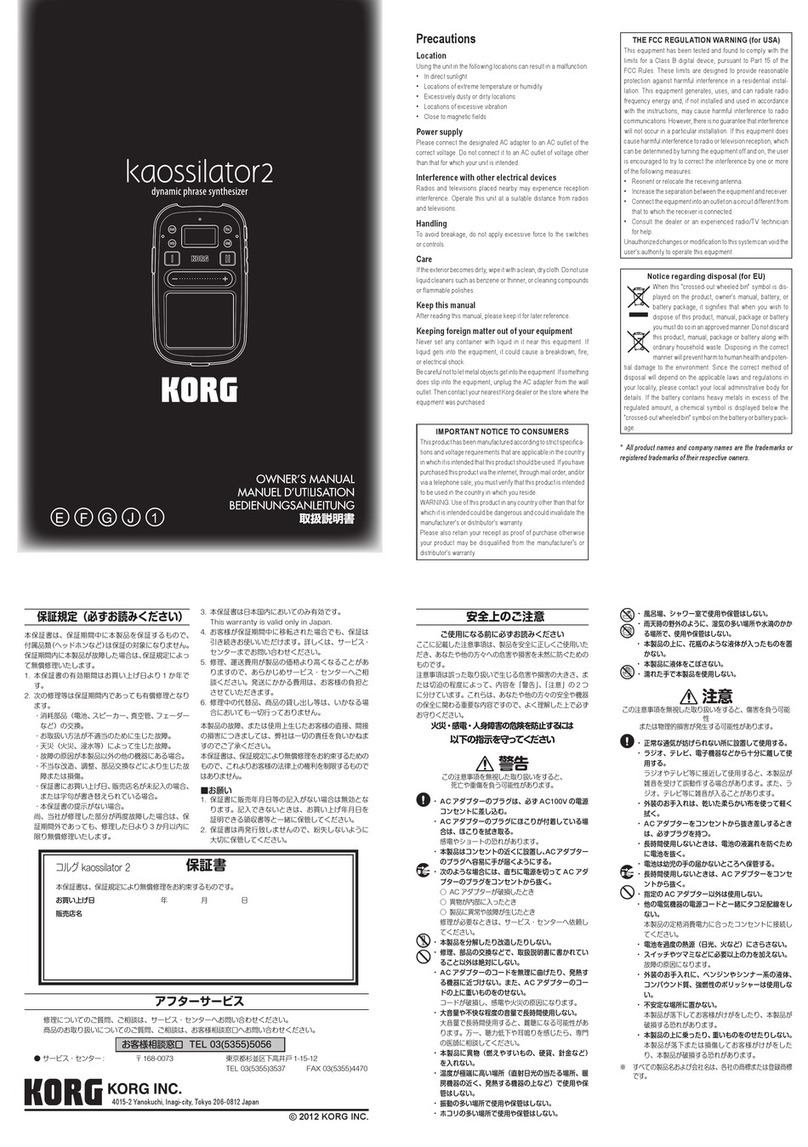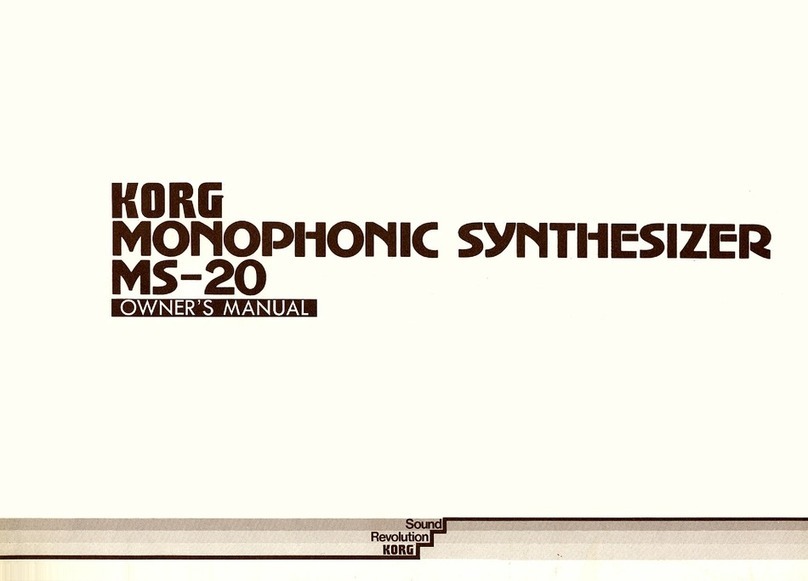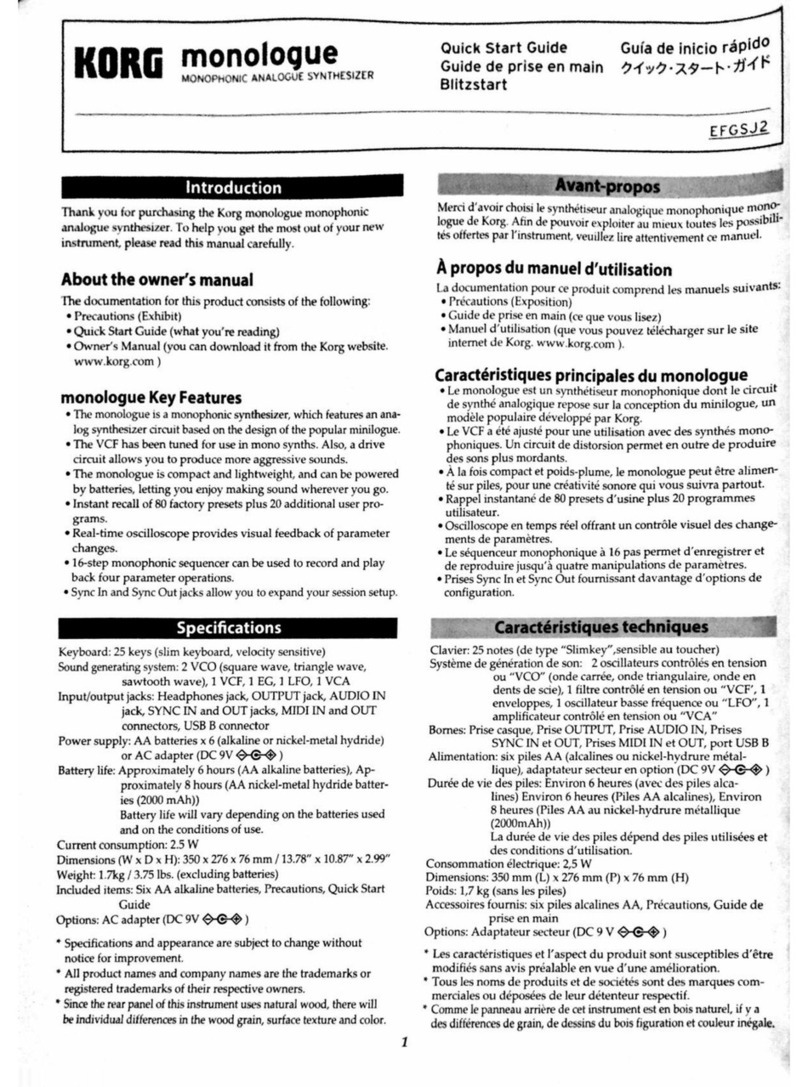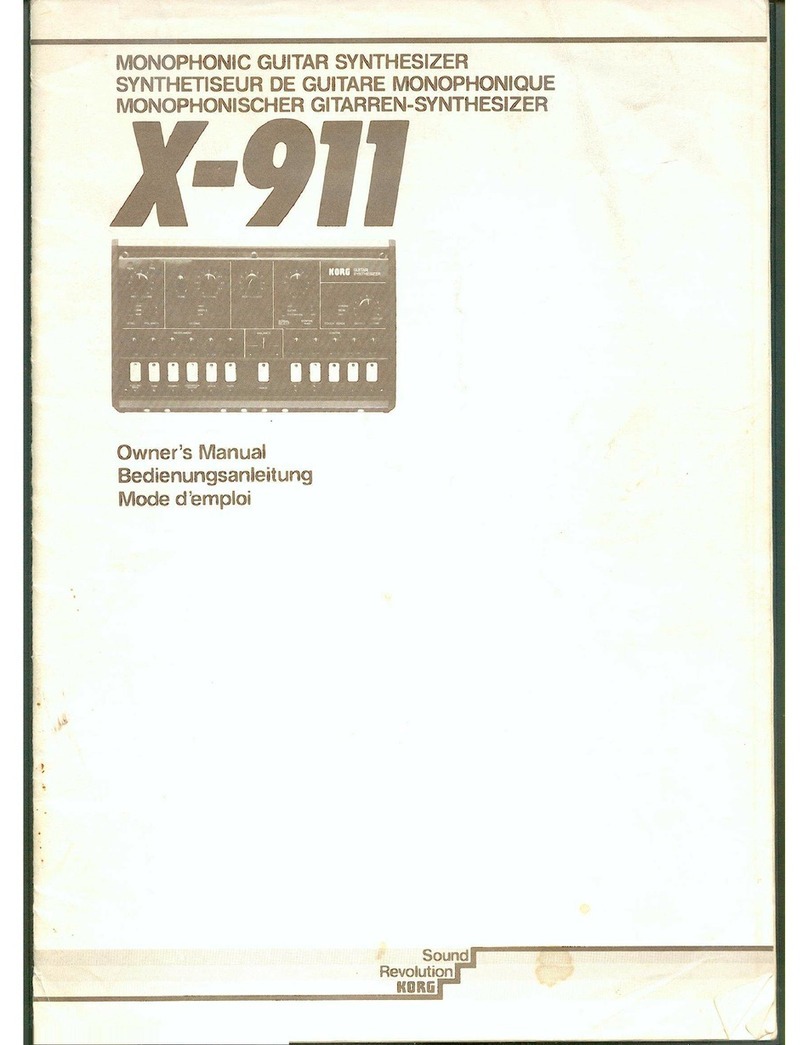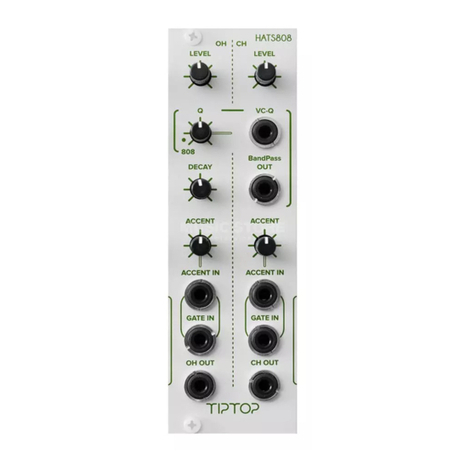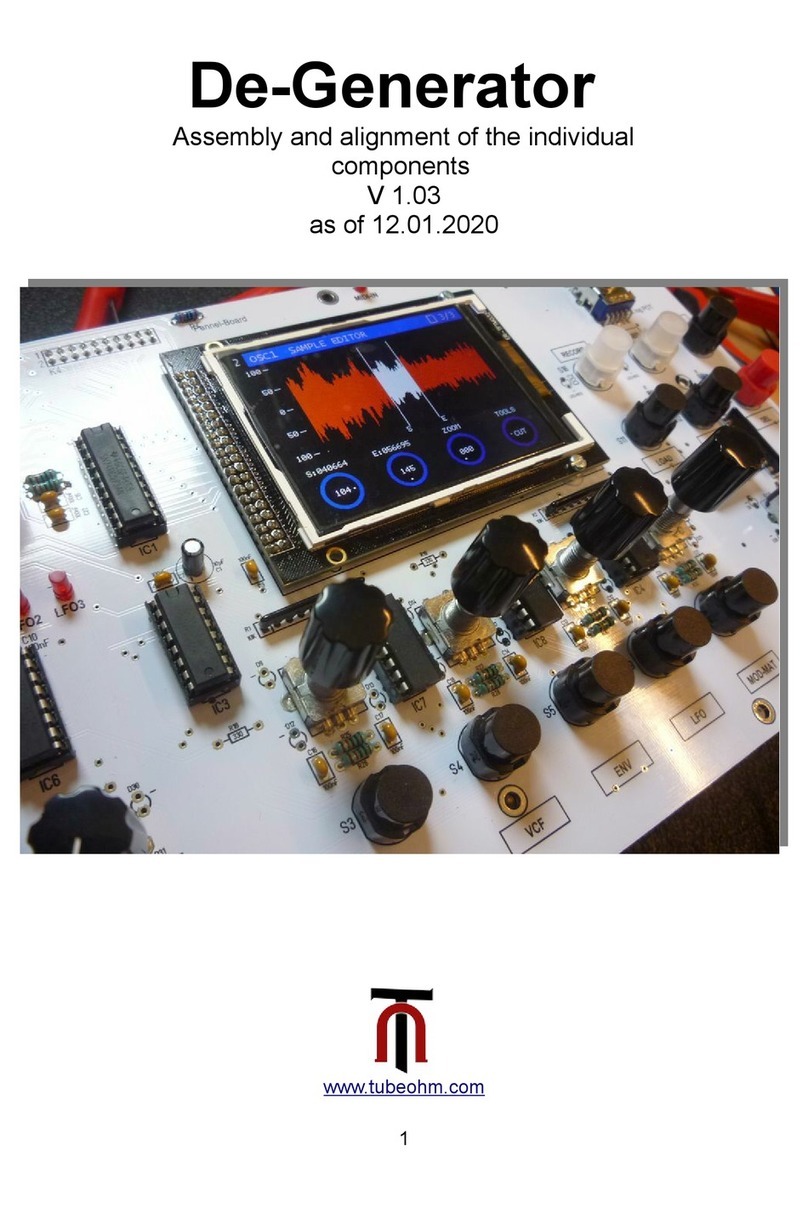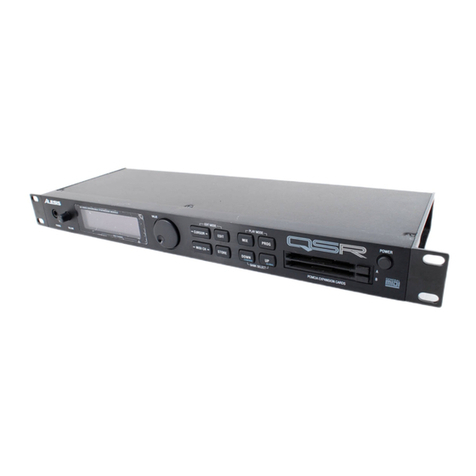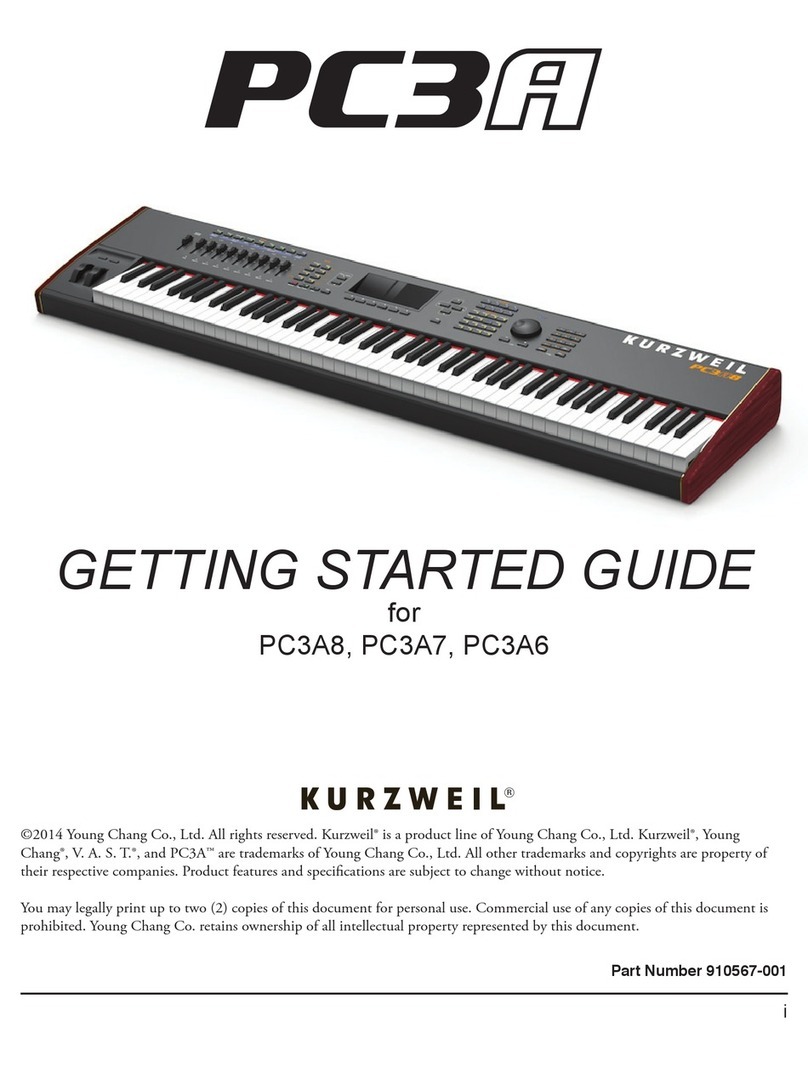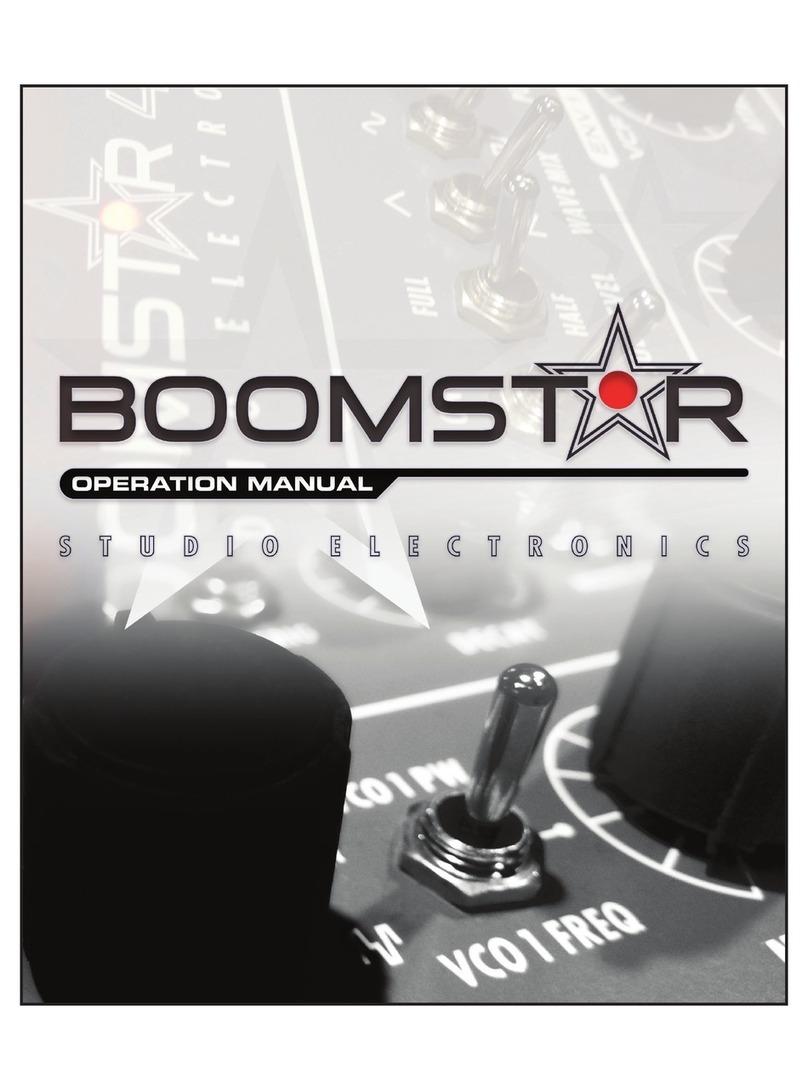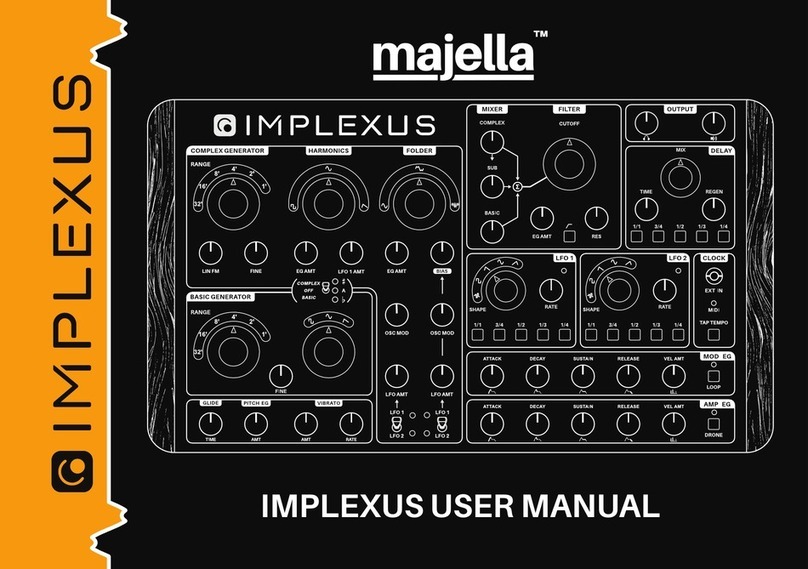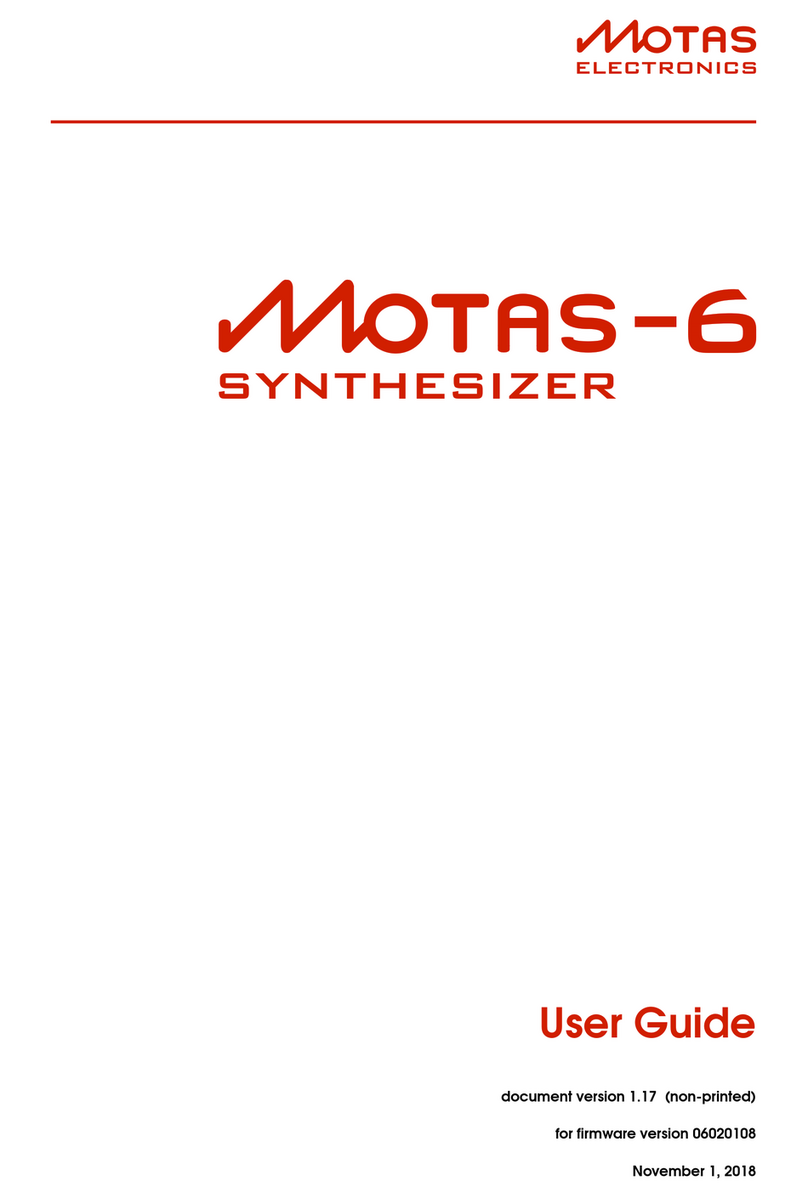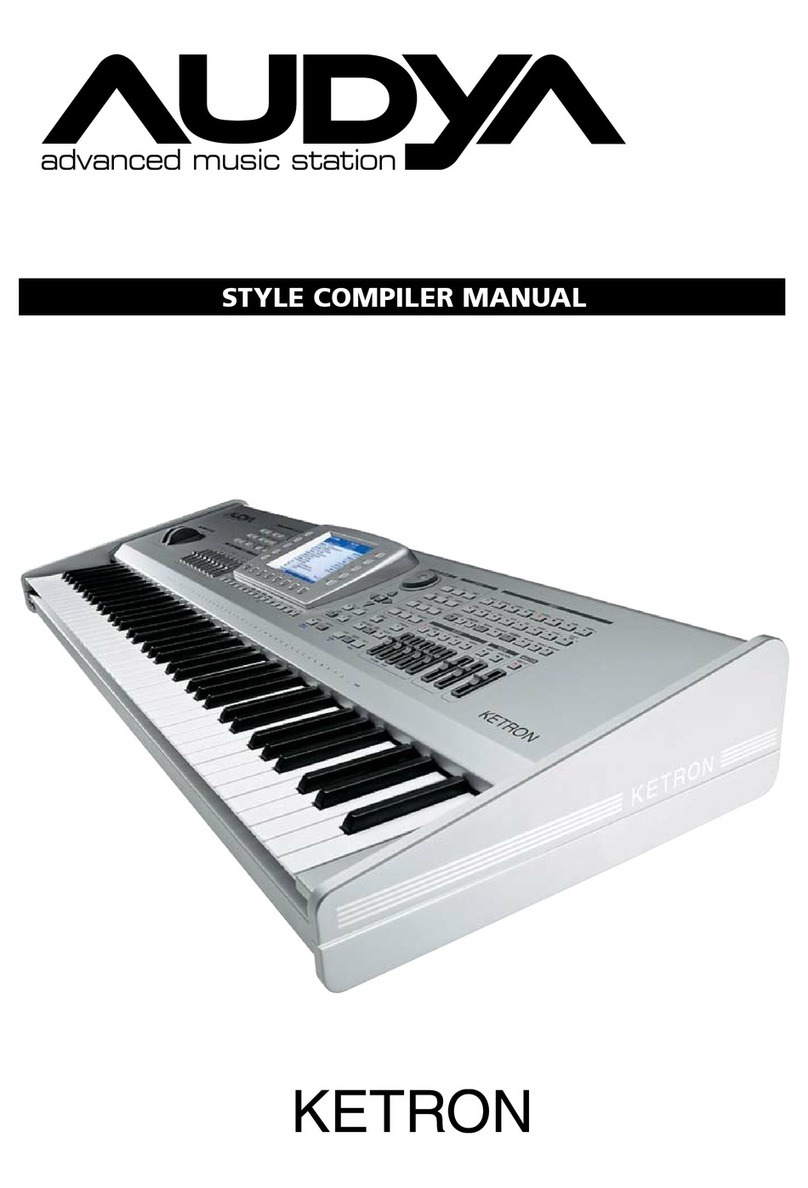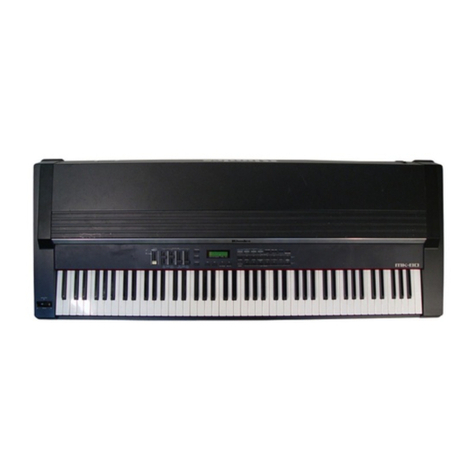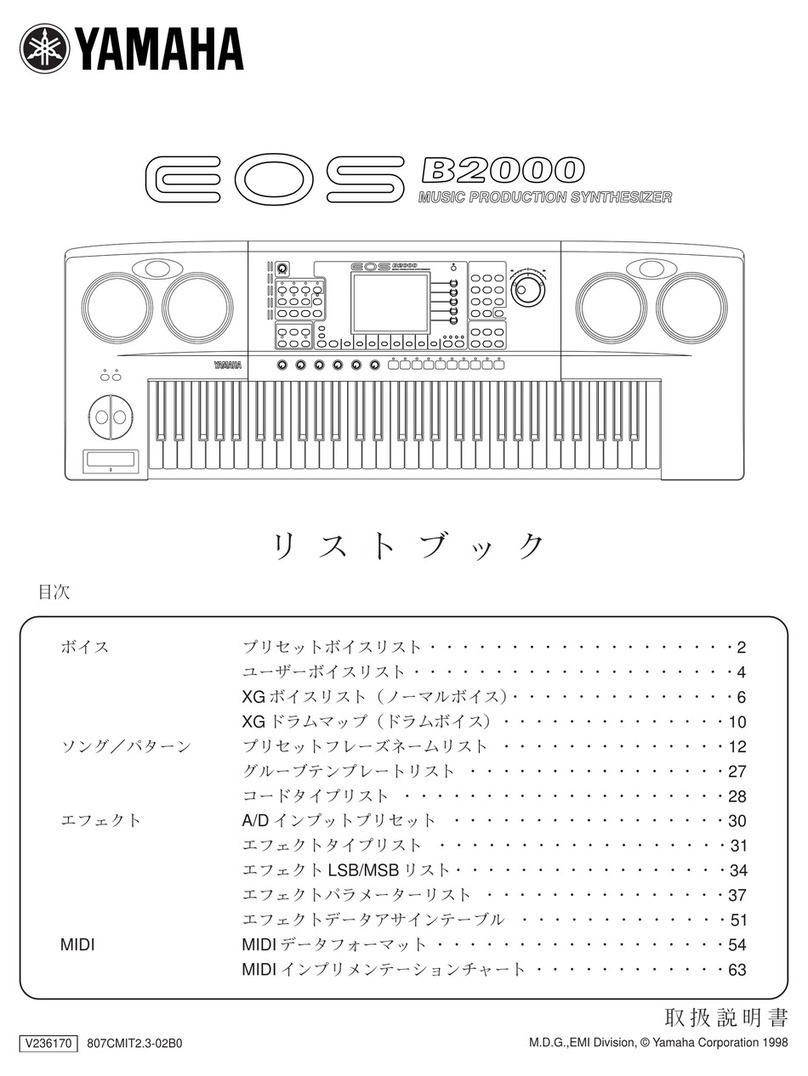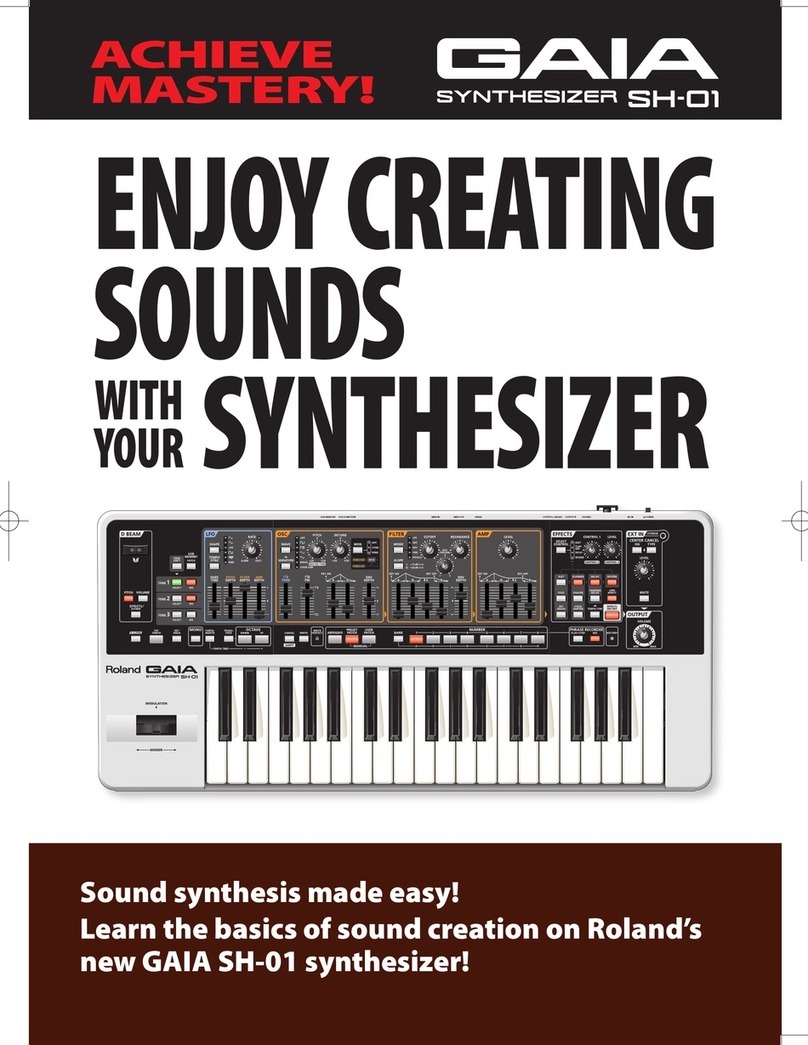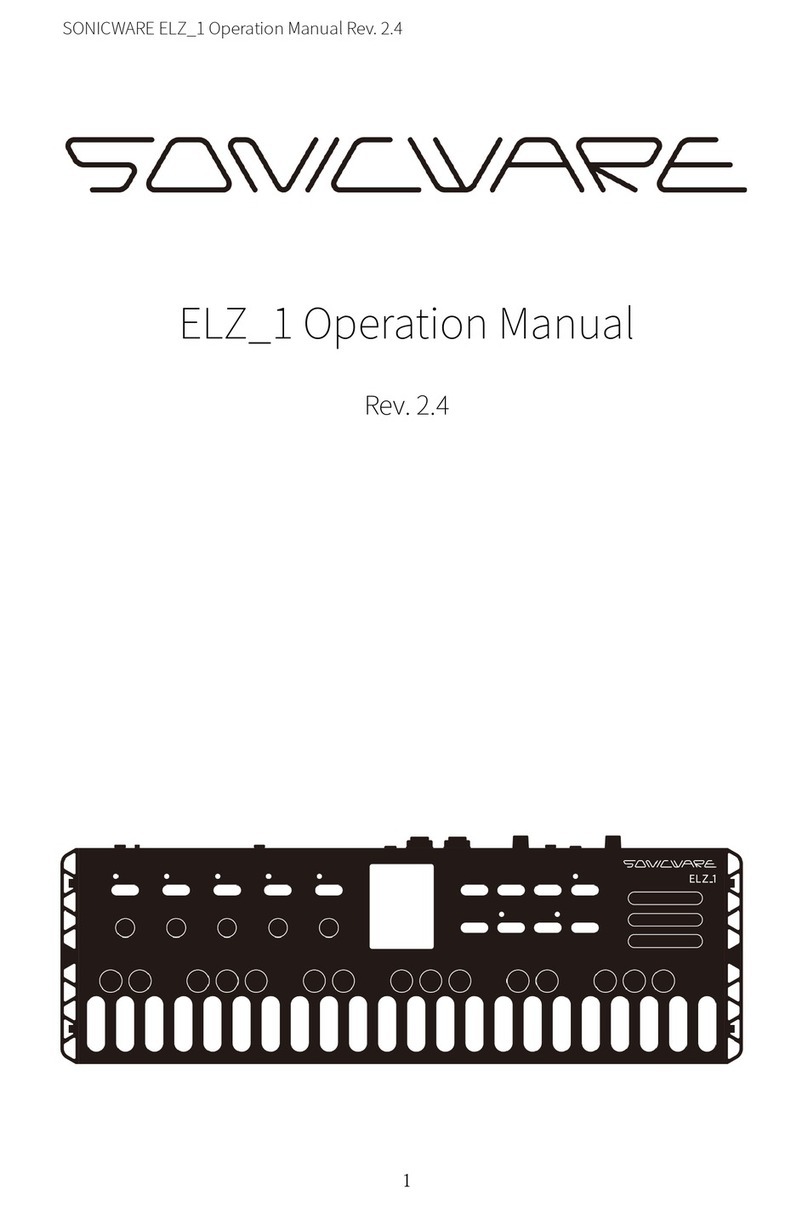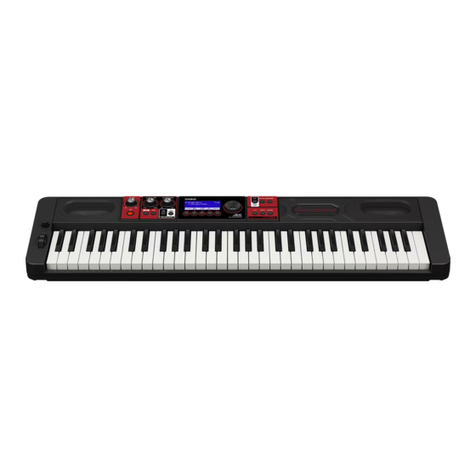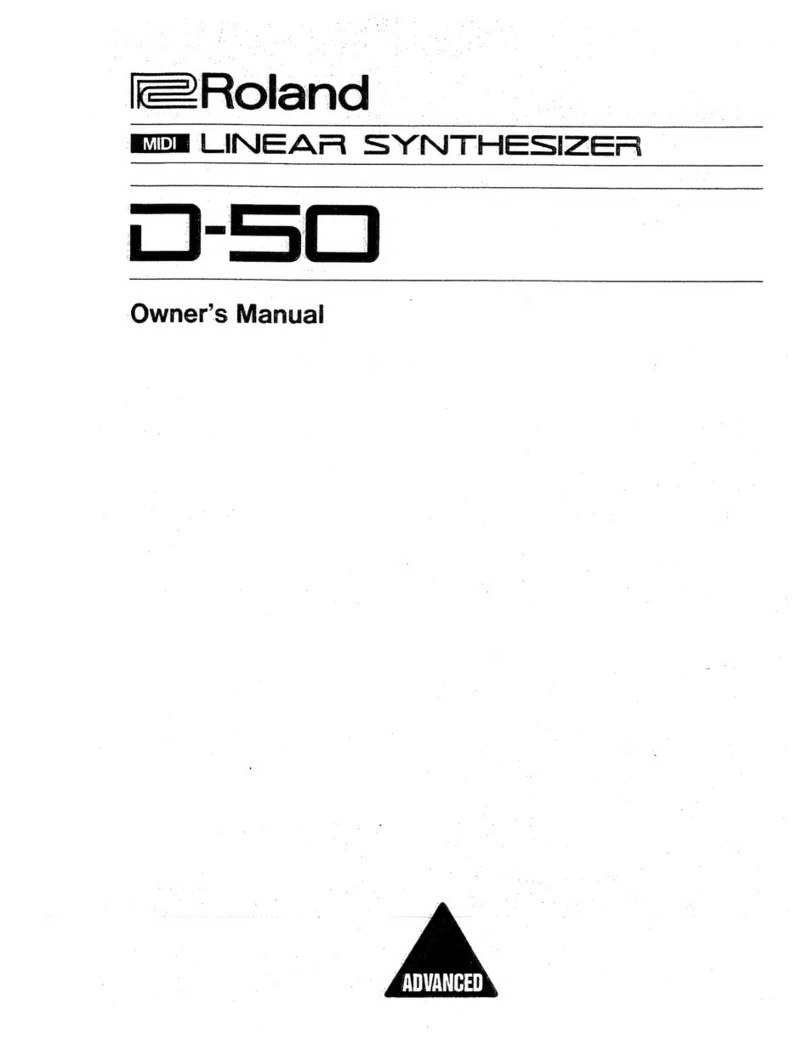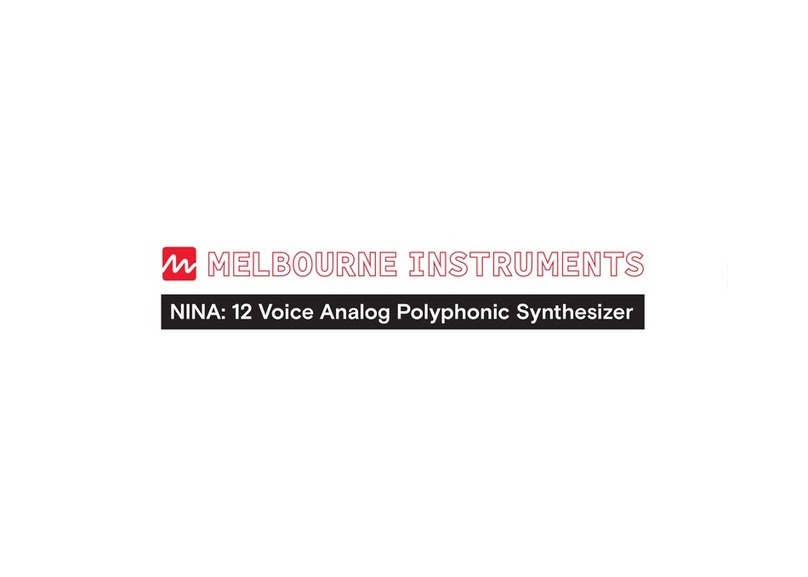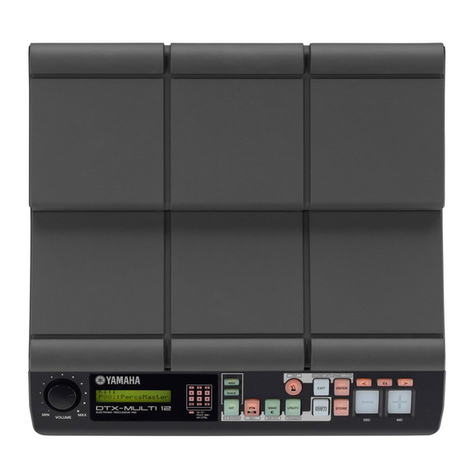Korg DW-6000 User manual

;|1
<?'
.^ v^irf.1
C~i
PROGRAMMABLE
DIGITAL WAVEFORM
SYNTHESIZER
OWNER'S MANUAL
1qt;o'^ ^'^"'

\
=T ""=«3t^
m°mmiKORG
PROGRAMMABLE DIGrXAL WAVEFORM SYNTHESIZER
Thank you and congratulations on your choice of
the Korg DW-6000. To obtain optimum perfomi-
ance from this advanced digital synthesizer,
please read this manual carefully before using.
IHas two Digital Oscillators per voice. Each
.oscillator has eight digitally encoded wave-
forms stored in two 256 l<ilobit ROM chips.
Unlike the simple sawtooth and pulse waver
forms of other synths, the DW-6000's w^vr'
forms are digitally encoded samples of ictu-
al acoustic instruments, to enable mora con-
vincing, realistic sound synthesis.
Anew kind of 6-voice programmable poly-
phonic synthesizer featuring an advanced
Digital Waveform Generator System (DWGS)
for sonic richness, plus powerful VCF, VGA
and EG modules, for excellent control and
flexibility.
'The DW-6000 features analog processing via
VCF and VGA modules, for ease of operati^
You enjoy the uniqueness of digital sou™
plus the fat sounds and ease of use of analog
control. ;

^n
mFEATURES OF THE KORG DW-6000
More flexible dynamic controi, witli two 6-
'parameter "ADBSSR" digital envelope gener-
ators per voice, one each for the VGA and
VCF, respectively.
7Programnnable Key assign nnode lets you se-
lect unison and polyphonic modes so you
can use the DW-6000 asaversatile mono-
phonic soloing or polyphonic synthesizer.
'64 different programs can be stored and ac-
^cessed by fingertip control. Afootswitch can
be used to advance the program number, for
on-stage convenience. 14 Rapid second
tape interface permits unlimited storage and
rapid reloading of program libraries.
Polyphonic Portamento, controllable by foot
(switch. Its setting can be stored for each pro-
grammed sound.
'MIDI equipped for full interfacing with other
MIDI equipped devices, including synthesiz-
ers, sequencers, remote (keyboards, expander
modules, rhythm machines, and personal
computers.
Noise generator Included for special effects.
i
Built-in stereo chorus for spacid'us stereo re-
production.

IMPORTANT ^AFFTY PRFrAIITinN^ ^
Please read and observe the following "J^^^^^'^^,, ,. ^,,,. ., .,,
^To avoid malfunction do not use this unit in the
precautions to assure reliability and safety. fonowmg locations tor long periods of time:
•In direct sunligfit.
•Exposed to extremes of temperature or humidity.
•In sandy or dusty places.
POWER SUPPLY
•Use only with rated AC voltage. If you will be using
this unit in acountry having adifferent voltage, be
sure to obtain the proper transformer to convert to
rated voltage.
•To help prevent noise and degraded sound quality,
avoid using the same outlet as other equipment or
branching off extension cords shared by other
equipment.
INPUT/OUTPUT JACKS AND CONNECTIO
CORDS
Be sure to use standard "guitar" cables with phone
plugs, such as the cable supplied with this instru-
ment, for input and output connections to the rear
panel of the DW-6000. Never insert any other l<ind of
plug into these jacks.
PREVENTING ELECTRICAL INTERFERENCE
As amicroprocessor based device, the DW-6000 is
extremely flexible in operation, yet may possibly
perform erratically if exposed to electrical in-
terference from other electrical devices and fluores-
cent lamps. Avoid operating the DW-6000 near pos-
sible sources of interference. If something seems to
be wrong, try turning off the power, waiting about
ten seconds, the turning it back on. This resets the
computer circuits to their initial state so perform-
ance should return to normal.
HANDLE GENTLY
Knobs and switches are designed to provide pc^*^
five operation with alight touch. Excessive force
may cause damage.
MAINTENANCE
Wipe the exterior with asoft, dry cloth. Never use
paint thinner, benzene or other solvents.
KEEP THIS MANUAL
Store this manual in asafe place for future refer-
ence.
MEMORY BACKUP
•To protect your programmed memory contents,
the DW-6000 utilizes abuilt-in rechargeable back-
up battery power supply. Battery life is rated at five
years or more, so replacement is recommended
after five years. Contact your Korg dealer or autho-
rized service center at that time.
•For maximum security, save your sound programs
on tape, using the built-in tape interface systap^
Then if memory contents are accidentally eras"--
or altered, you can simply load the data back into
DW-6000 internal memory in seconds!

CONTENTS

FRONT PANEL LAYOUT
^'^<^
[r:u:i_r
^J¥
,- ^^^^^ '^>i'*

,»>
sP
^'
«2S'

REAR PANEL LAYOUT
.•^-^^.o^^
MIDI equippea syn-
thesizers, sequencers, or
computers.
Computer
Tape decks, radio-
cassette recorders, or
tape recorders.
(WEth recording and
playback functions)
Footswitch
m.
{:j_GND type footswitch)
Mixers, arnplifiers, or
stereo systems.

DW-6000 OVERVIEW
The DW-6000 uses anew digital method of sound generation called "Digital
Wavefornn Generator System" or DWGS. Korg developed DWGS to provide ahigher
level of realism and richness together with the ease of operation of conventional
analog processing.
What is DWGS?
Conventional synthesizers use VCOs or DCOs whicii pro-
duce simple waveforms such as the typical sawtooth,
triangle, pulse, square, etc., found on normal synthesiz-
ers. However, to obtain the richness of real instrument
sounds, you need amore complex harmonic structure
than these conventional waveforms provide. Korg's
-S^GS uses eight digitally encoded waveforms having
we complex harmonic structures required for profes-
sional music. These waveforms are based on actual
samples of real musical instrument sounds (violin,
acoustic piano, electric piano, saxophone, etc.),
recreated by additive harmonic synthesis.
The DW-6000 uses two DWGS oscillators per voice so
you can mix different waveforms in variable proportions
to create even more complex and unusual sounds.
What's more, the DW-6000 uses analog VGA and VCF
modules so you retain the familiar operation of conven-
tional synths. You get fast, predictable results without
the programming and control difficulties of "digital"
systems. On the DW-6000, synthesis is straightforward,
following basic synthesizer theory of pitch, timbre, and
volume parameters.
DW-6000
Basic Functions
This manual covers the followmg basic functions.
$oiin£l Creation
How to create and alter
sound.
Writing Proflfams
How to store sounds in
the DW-6000's program
memory.
Selecting Programs
How to call up your
stored sounds.
Peirformance Effects
How to use effects
such as Pitch bend,
modulation and porta-
mento wtiile playing.
rOscillator Section (Digital)
(*-,i
hi ii
u-^ [Wimiiiiii ImI I
Q/
OUT
PUT

1. BASIC SETUP
Before using the DW-6000, fallow these steps.
[IIMake sure the power switch is off.
(The power switch is on the left side of the rear panel,
as seen from the rear.)
r-'
[•Ul POWER
mPlug the AC cord into awall socket.
Attached power cord Rear view
13] Turn down amplifier volume and connect the DW-6000
OUTPUT jack{s) to the amplifier or mixer input jack(s).
Set the LOW/HIGH switch according to the kind of amp
or mixer input used.
•ID •@@© @» 7
To amp or mixer
Type of input
HFor operation without an amp or mixer, plug standard
stereo headphone into the PHONES jack on the rear
panel.
Use L/MONO for
connection to asin^f~~~^.
gle amp or mixen
channel.
Switch position
Audio amp (AUX IN)

2. SELECTING PROGRAMS
i^is explains how to select any of the 64 different sounds stored in the DW-6000's
nnemory. The PROGRAIVIMER section on the front panel is used for this purpose.
Features &Functions
4PROGRAM NO. display
56VS
#
1234
y
1PROGRAM
switch NUMBER
keys 3BANK
HOLD switcli
fPHOGRAM swmSH
When this switch is activated (and its LED indicator is
on), different programs may be selected using the
NUMBER keys.
1NUMBER keys
Press these l<eys to specify program numbers, which
range HRs from 11 through 88. Programs are arranged
in eight "banl^s," signified by the left digit, with eight
programs per bank, signified by the right digit; 8x8 =
64 total programs.
Bi^NK MOLD switch
This holds the left "bank" digit so that you can use
single number keys to quickly access any of the eight
program numbers within asingle bank.
:t PaqGRAM NQ. display
Shows selected program number.
About Program Numbers
The DW-6000 can be store up to
64 different sound programs in its
internal memory. Each of these
\;0)grams has anumber from 11
through 88 (the digits and 9are
not used). When you want to store
asound, you must assign it apro-
gram number. When you want to
recall that sound, you select it by
the same program number.
IEvery sound gets aprogram number
Writing programs
Sound program memory (64 total)
You select the program number of the sound that you
want to play or edit.
11

SSELECTING program;
How to Select aProgram Number
»>
When you first turn on the DW-6000's power, the display will appear as shown here and the PROGRAM LED indicator
will be on.
^rri
J:V^:T1'i;!.l
r
l:f.1:f:T,'.U;jj;!.l
-LED is on
PROGRAM PARAMETER
^4-J
VALUE will .display the
programmed value for
parameter //of program
Now if you play the keyboard you will hear the sound of
program number \'. Adjust the volume and see what it
sounds like.
To select other programs:
-^
mPress the PROGRAM switch (if not already on). An LED
will light above the switch. B-LED is on
[U Press the NUMBER keys to seiect any program number (/,' ~8'3 )
.
Example: To select program numberi?^...
Press
Display
Adash appears in the right
hand digit until you select the
second digit. (This means it is
waiting for you to select the
second digit.)
@Press
liiii'Wiriii'jii
BANK HOLD
If you turn on the BANK HOLD switch the left digit (bank number) will be "locked." Depressing NUMBER keys will nov^
only change the right digit "program number." This is the fastest way to select different programs within abank.
3] Pressing the BANK HOLD switch preserves the left
digit of the selected program number.
E^m
IJ=l.!r1:M,',IJ[.l
INow press BANK HOLD.
'LED dot lights.
An LED dot lights up to in-
dicate that the bank num-
ber (2) will not change.
BAWKHOLD
^Now if you press any of the NUMBER keys, only the
right hand digit will change.
i-.].r.W:T.v.i?i.i
Only this digit changes when you press the
number keys.
OWhen you want to change to aprogram number in adif-
ferent bank, press the BANK HOLD switch again to
cancel BANK HOLD. You can now enter both digits us-
ing the NUMBER keys.
3ANK HOLD

3. CREATING SOUNDS
to Make New Sounds
Features &Control Functions 8PARAMETER
NUMBER display 9VALUE display
1KEY ASSIGN section
::'.'ti7vi;'< "^'^^^''^^'^i^*':-
5678
^^
PROGRAMMER
2EDIT
SLIDER 3/4 DOWN/UP
keys 5PARAMETER 6NUMBER Keys 7BANK
switch HOLD
switch
;1 KEY ASSIiiNlsectlon
The DW-6000 offers the user achoice of three dif-
ferent ways to assign voices from the keyboard (call-
ed "Key Assign Modes"): P0LY1 is the "standard"
polyphonic keyboard mode, for playing chords and
melody lines.
P0LY2 is intended particularly for portamento chord
work. UNISON combines all voices and one note, for
rich and fat soloing sounds.
t£DlTSLlOER
Permits rapid and easy adjustment of parameter
VALUES {aspects of the sound) over awide range.
3tt,DQWMUPI^m
Press to change parameter values up or down astep
at atime.
5PARAMETER switch
When this switch is on, you can create and modify
sounds by selecting different parameters {using the
NUMBER keys) and varying their VALUEs (using the
EDIT slider and/or DOWN/UP buttons).
€NUMBER Keys
These keys are used to select diffeent Parameter
Numbers (when the parameter switch is on).
ISflANK HOLD switch
This holds the Parameter Number's left digit, so that
the NUMBER keys can be used to select only the right
digit. This can speed up Parameter Number selection
when you are working on several parameters within
the same "family" (that is, having the same left digit).
8PARAMETER NUMBER display
Shows selected parameter number.
Shows current VALUE for selected parameter.
^bout the DW-6000's "Digital Access Control System"
The various aspects of asound, such as its pitch, timbre
and variations in volume, are called "Parameters." To
create or change asound, you adjust the values of each
of these parameters.
On the DW-6000, there are 34 parameters per program;
each parameter has anumber, and each parameter's
value is also represented by a number. These numbers
are shown on the front panel display. To create or
change asound, you select parameters and change (or
[—•Using the Parameter Index
"Edit") their values.
When the DW-6000 stores asound in memory or calls it
back from memory, it is actually storing and recalling the
values you have given it for the sound's various parame-
ters. All possible parameters and values are listed in the
"parameter index" chart on the right side of the DW-6000
front panel. To create or change asound, you first use
the number keys to select aparameter number, then you
use the edit slider and up/down keys to change its value.
PflRAWlETER LIST
[77 !s- 5- .- ;.--

3CREATING SOUNDS
The DW-6000 Approach to Sound Synthesis
To create new sounds on the DW-6000, you change or edit
old programs. You do not start with a"blank slate". There
are 64 sounds already in memory, if you have anew sound
in mind, the easiest approach is to first select asound that
resembles the sound you want to create. Then "edit"
{change the selected sound until you get the sound you
want, if you don't find asimilar sound, it doesn't matter;
start with any sound you like.)
After you finish editting your sound, you store it into
memory. This is called "writing aprogram to memory". At
this point you can give it adifferent program number
{thereby preserving the sound you started with) or the
same program (thereby erasing or "overwriting" the old
sound).
Selecting a
Program: Find-
ing acurrent
programmed
sound that re-
sembles the
new one you
..wish to create.
Creating
Sounds (Edit-
ing): Changing
the values of
the parameters
•that ne^ to be
changed to ob-
tain the desired
sound.

3CREATING SOUNDS
Parameters and Values
This section describes each module (such as Oscillator 1, VCF, etc.), its parameters
(such as Octave, Waveform, etc.) and the results of using different values within
each parameter.
OSCl
I* !I'lliff"
Ut,tA^;b
t i iQ' Q' a' /^ 'S\tj n^31
Parametei^ in this module determine tiie basic pitoh
range (OCTAVE) and timbre (WAVEFORIVI).
WAVEFORM
OCTAVE
Here you select the basic pitch range of oscillator 1. The
higher the value, the lower the pitch. You have three
choices which correspond to IB' (16 foot), S' ,4'.
VALUE

%Jy^Irfltom^ilCM
Bi^V" OCTAVE
8' H' cc P3
JNTERVAL
This is yoyr second sound soorce, designed to be us-
ed together with 0SC1 to create thicker, richer and
more comjiriex sounds.
KiniQP
jESdJIV ihteL
Provides white noise {a mixture of all frequencies) as a
separate sound source. This is useful lor adding
"breath noise" to simulated acoustic instrument
sounds, and for creating special effect sounds such
as wind, surf, gunshot sounds, etc.
iOCTAVE
As with 0SC1, you have achoice of three pitch ranges: V,
8', and IS'.
^OWAVEFORM
Once again, you have eight waveforms to choose from.
V
ILEVEL
Adjusts output level as in 0SC1
MHLEVEL
Adjusts noise volume.
VALUE

3CREATING SOUNDS
•
VCF
22 3H POLARITY
IS
This DW-SOOOOs six voEtage controHed filters (one per
voice) remove or emphasize portions of the basic
waveform liarmonics. This affects the timbre of the
0SC1, 0SC2, and NOISE waveforms. These VCF are
ioW"pass filters, which remove ft^quencios above the
selected CUTOFF frequency (while al lowing lower fre-
quencies to pass through).
eSBI CUTOFF
This determines the cutoff frequency of the low-pass filter,
higher the cutoff frequency, the less effect the filters
¥^e on the basic waveforms (since more frequencies are
passed).
Low-pass filter cutoff frequency.
Frequencies lower
than cutoff fre-
quency are passed.
Frequency
Cutoff frequency
Value —63
At the highest value, 'oB, all harmonics are passed. The
lower the value, the more harmonics are cutoff, so the
sound becomes progressively rounder or less bright.
VALUE

3CREATING SOUNDS
IPOLARITY
Determines how the VCF cutoff frequency is affected by
the VCF EG (Envelope Generator). With normal polarity
(VALUE =1), the cutoff frequency rises during the EG's
Attacl< and falls during Decay (as with most musical in-
struments); use "Inverted" polarity (VALUE =?), for
special sounds where you want the opposite effect.
VALUE

3CREATING SOUNDS
VCF EG. VGA EG
ATTACK
I-} (u^•" ..I (
mlSS^Kf ATTACK
S~ II"' «.?'
H^
KRE#.Kt>.
-31
s? C5ECAV
JI-S3
These two envelope generators control the "contour"
(or (Ganges over time, in terms of the sound's attack,
sustain, decay, and other dynamic characteristics) of
each programmed sound. The VCF EG determines
how the timbre, or brightness, changes over time.
The VGA EG determines how volume changes over
time. The DW-6000 utilizes advanced 6-stage EG
modules with "break point" ami "slope" rate
parameters in addition to the conventional attack,
decay, sustain and release parameters. Six parame-
ters of ADBSSR envelope generators.
vv H'5 %RELEASE I
SO
r!+
ss Do
Six parameters of VCF EG and VGA EG.
*- Time
ATTACK (Rate)
Controls how long it takes for the volume or cutoff fre-
quency to rise from zero to its maximum level after anote
Is played on the keyboard.
DECAY (Rate)
Determines how long it takes for the volume or cutoff fre-
quency to fail from its maximum attack level to the break
point level.
BREAK P. (Break Point Level)
Determines the level at which volume or cutoff frequency
i^ops dropping during the decay, if this Is set to the same
^value as the sustain level, then the envelope becomes a
conventional ADSR type (as if It had no break point or
slope parameters).
SLOPE (Rate)
Determines how long it takes for volume or cutoff frequen-
cy to change from the break point level to the sustain
level. Note that if the break point is lower than the sustain
level, then the slope functions as asecond attack. If the
break point Is higher than sustain, then slope functions as
asecond decay.

3CREATING SOUNDS
i
MG
£3 £';
This stands for Modulation Generator. The !VIG section
utilizes alow frequency osciilator to modutate the
DW-6000's oscillator pitch (creating vibrato effects)
and/or VCF cutoff frequ^icy (creattng filter mod or
"wah-wah'' effects). i
FREQ
Determines the speed of the cyclic pitch or tonal variation.
The higher the value, the faster the speed. VALVE
Other manuals for DW-6000
1
Other Korg Synthesizer manuals
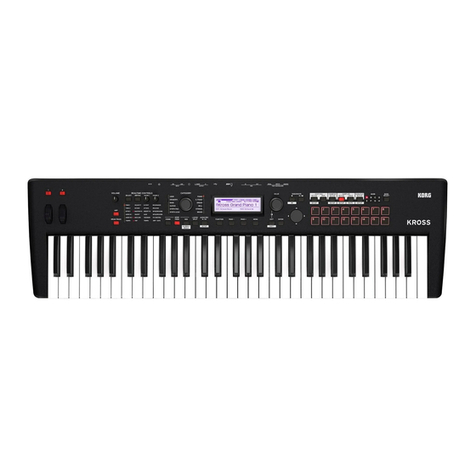
Korg
Korg KROSS User manual
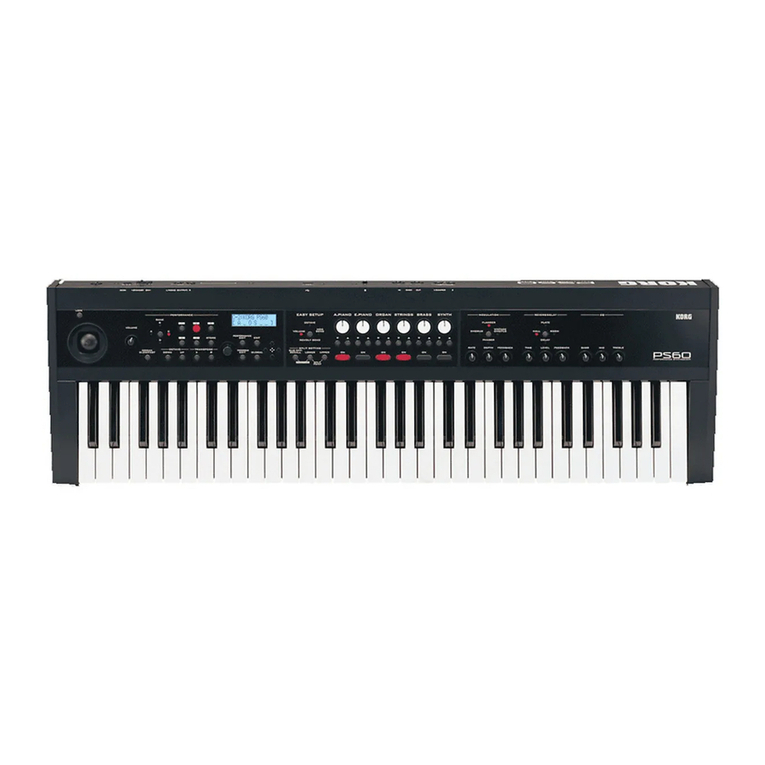
Korg
Korg PS60 User manual
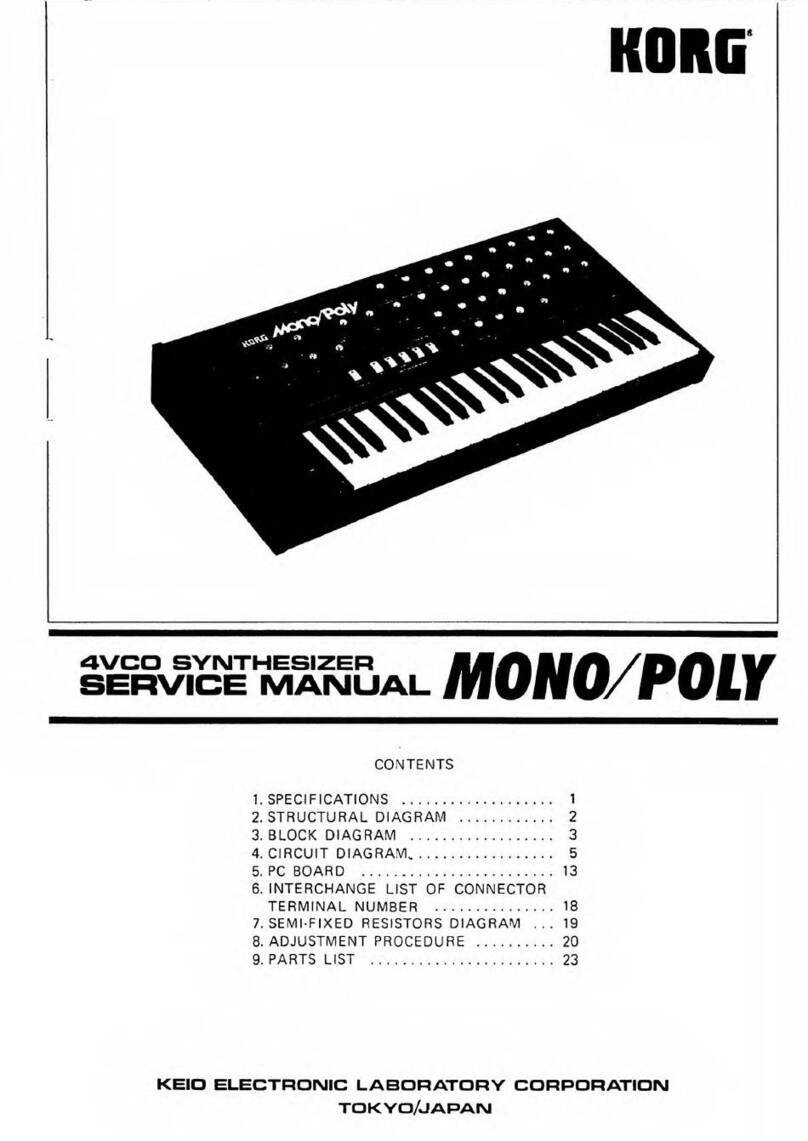
Korg
Korg Mono/Poly User manual
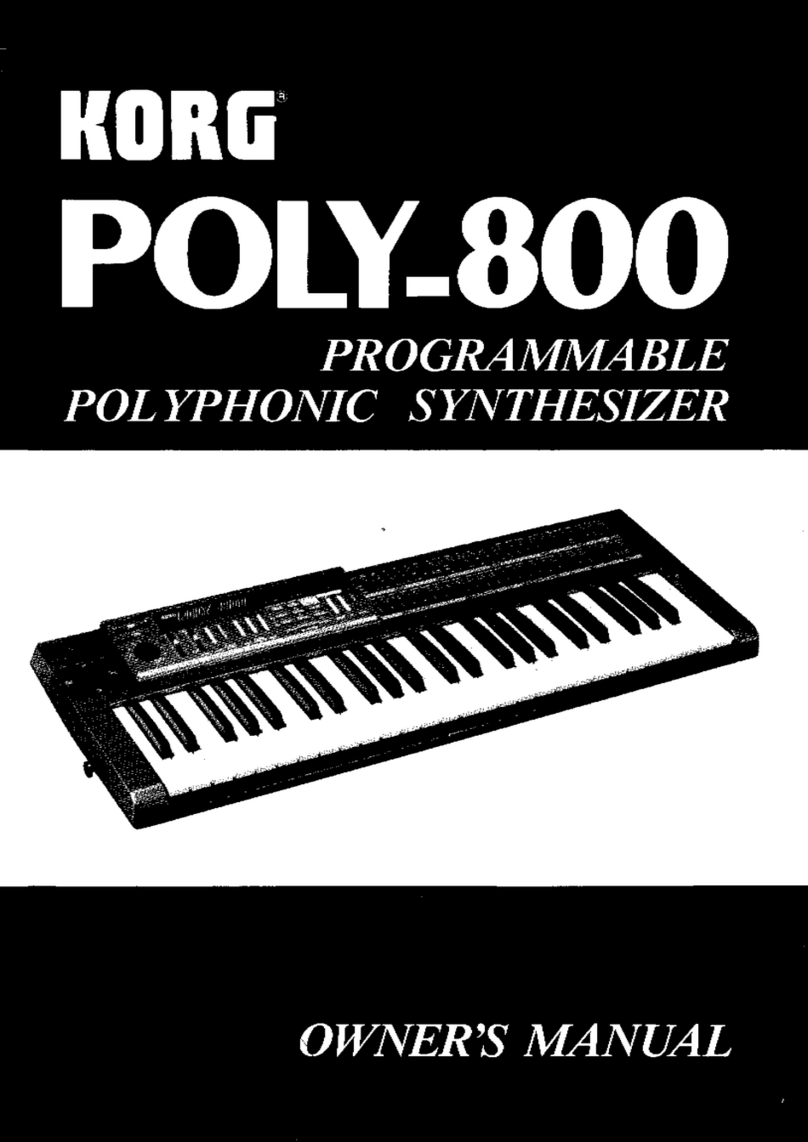
Korg
Korg Poly-800 User manual
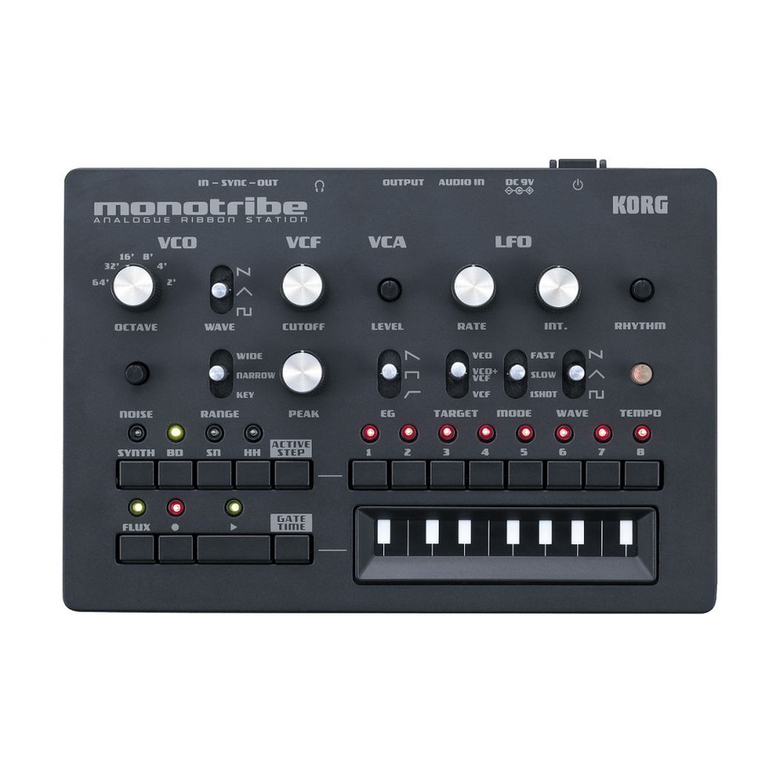
Korg
Korg monotribe Use and care manual

Korg
Korg MMT RADIAS User manual
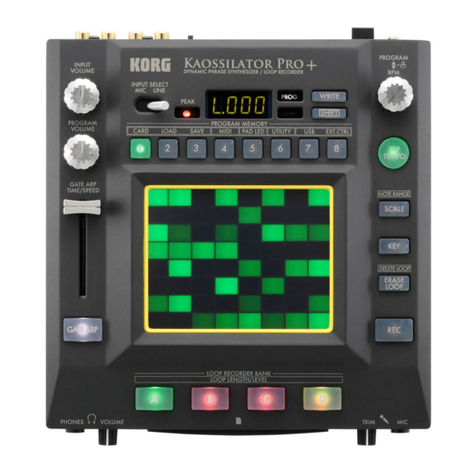
Korg
Korg Kaossilator Pro+ User manual
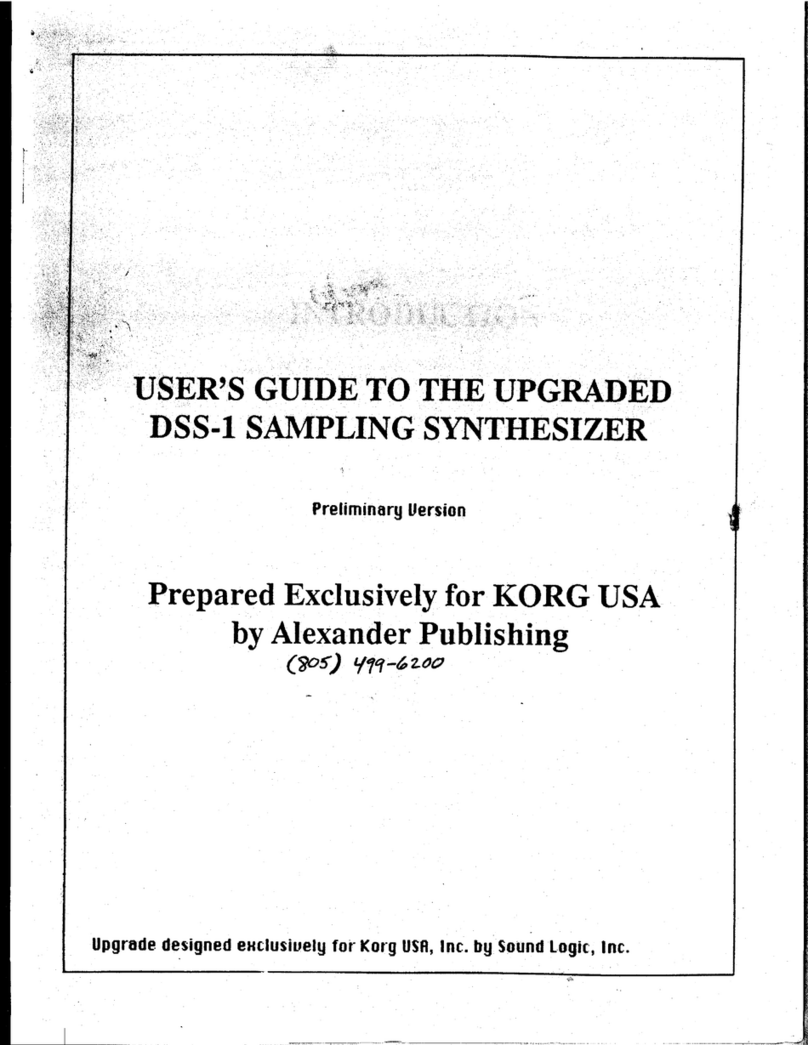
Korg
Korg DSS-1 User manual
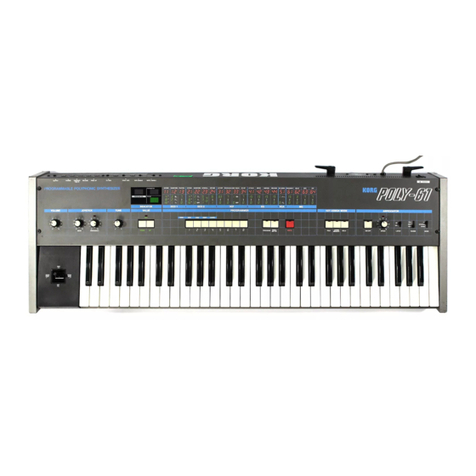
Korg
Korg POLY 61 User manual
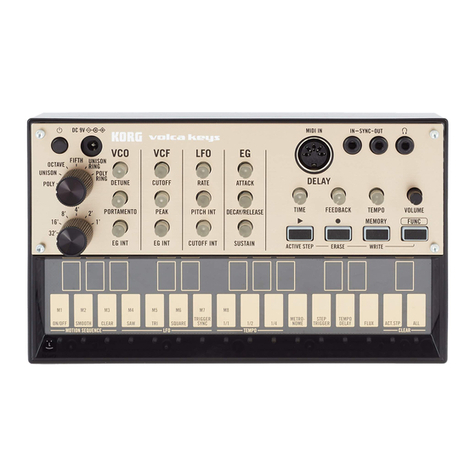
Korg
Korg Volca keys Use and care manual

Korg
Korg MONOPOLY POLYSIX MS-20 User manual
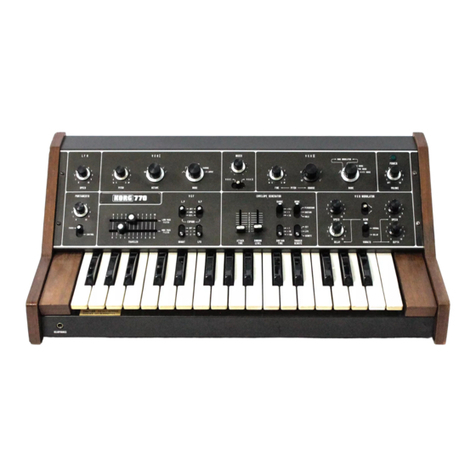
Korg
Korg 770 User manual

Korg
Korg Poly-800 User manual

Korg
Korg KROSS User manual
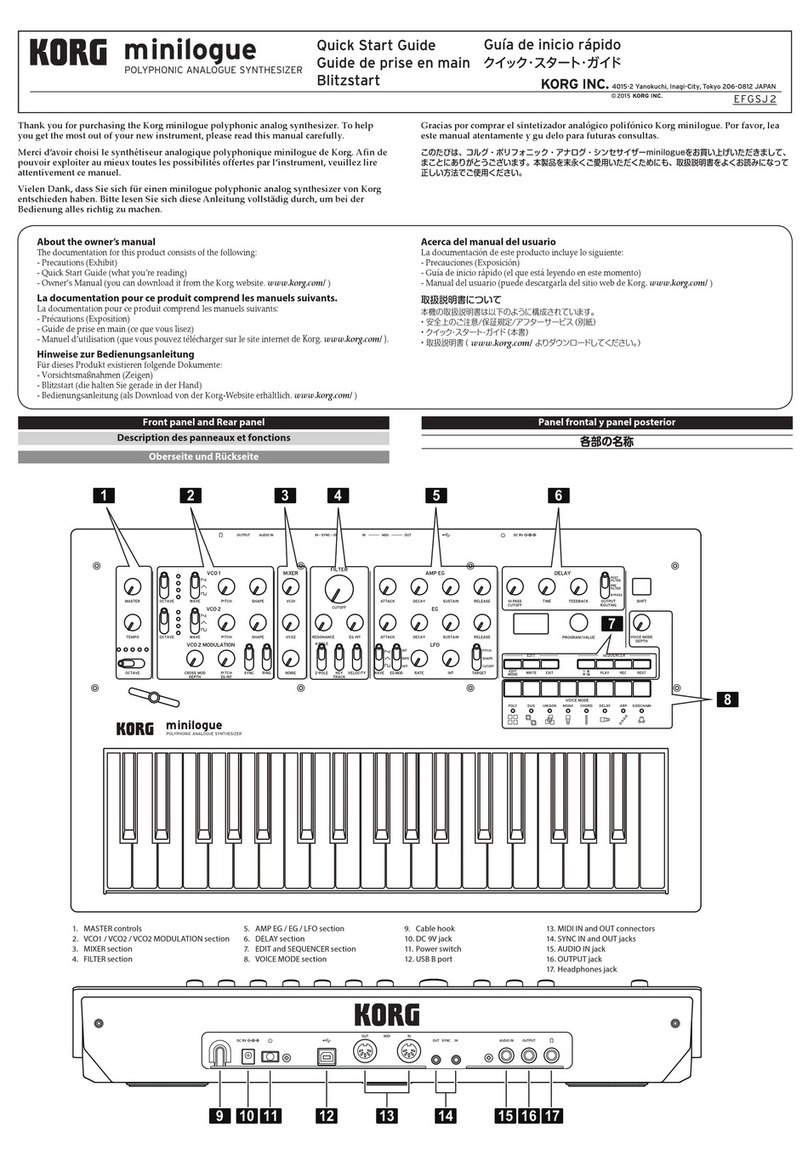
Korg
Korg minilogue User manual
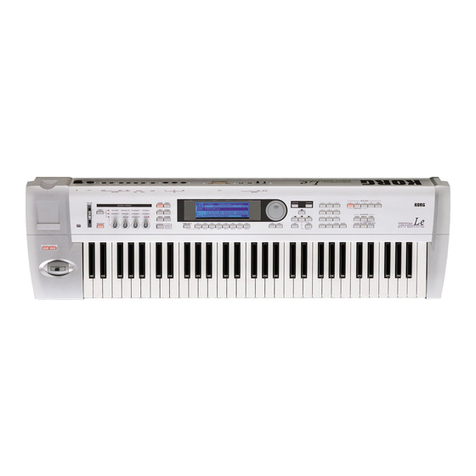
Korg
Korg TRITON Le User manual
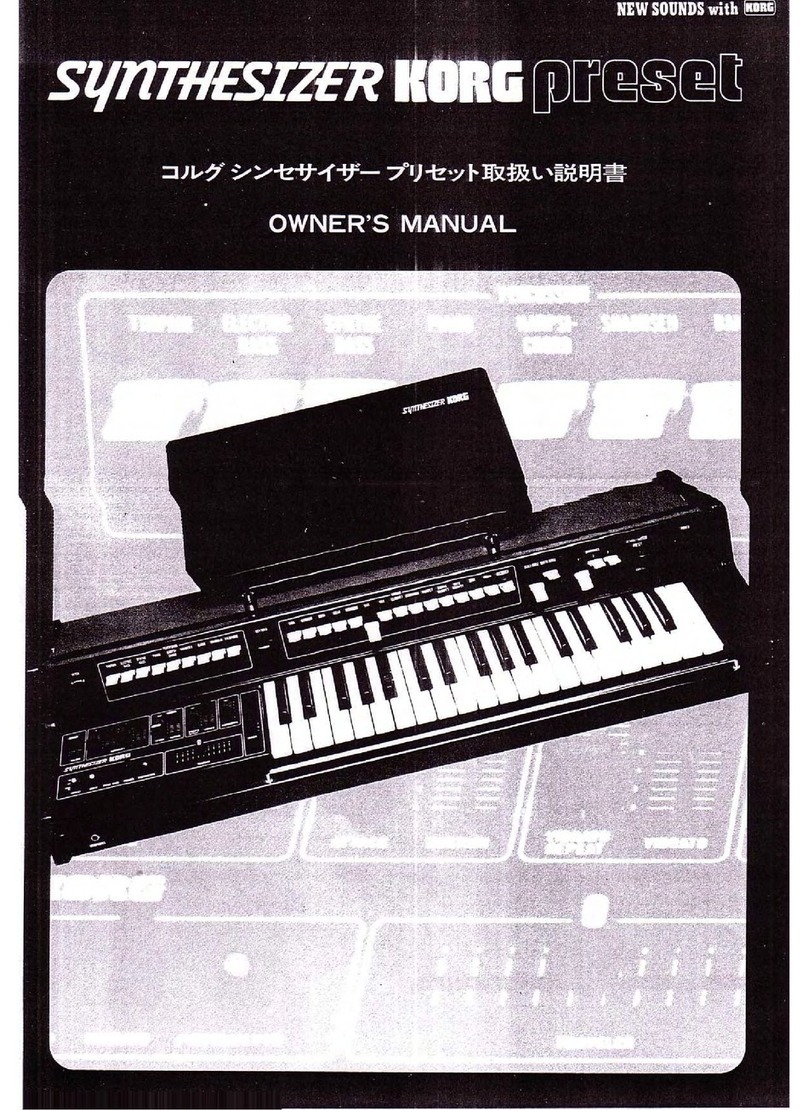
Korg
Korg Preset Synthesizer User manual

Korg
Korg wavestate User manual
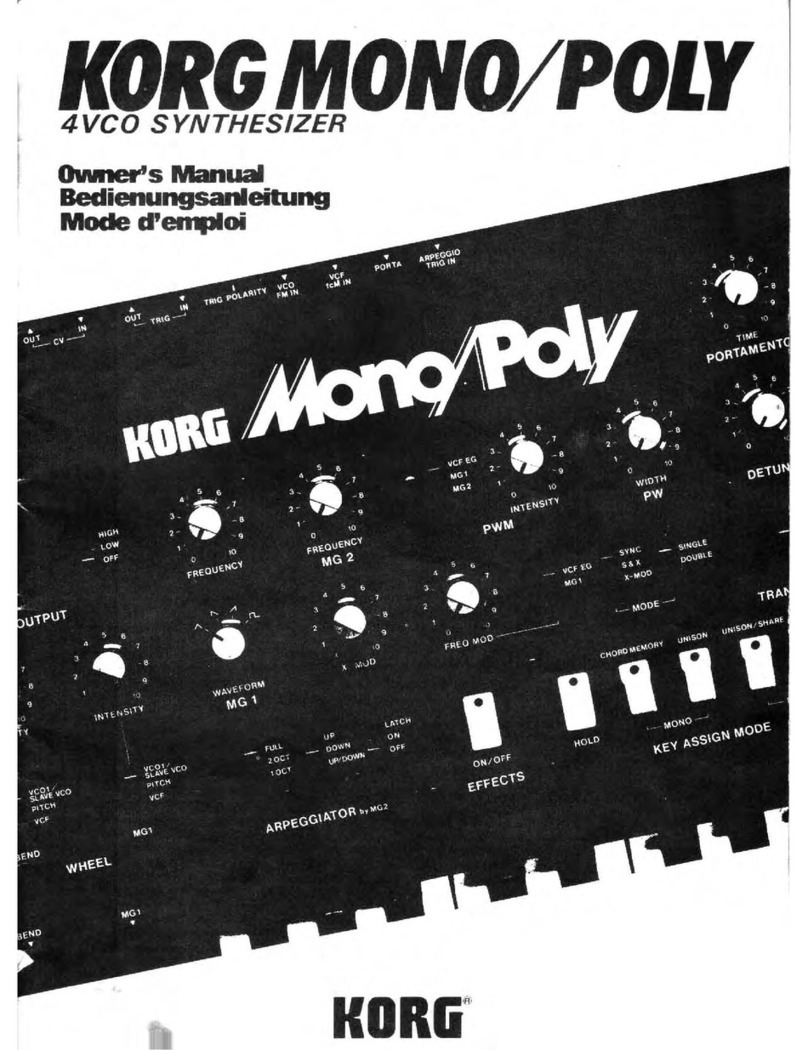
Korg
Korg Mono/Poly User manual

Korg
Korg M1 User manual
